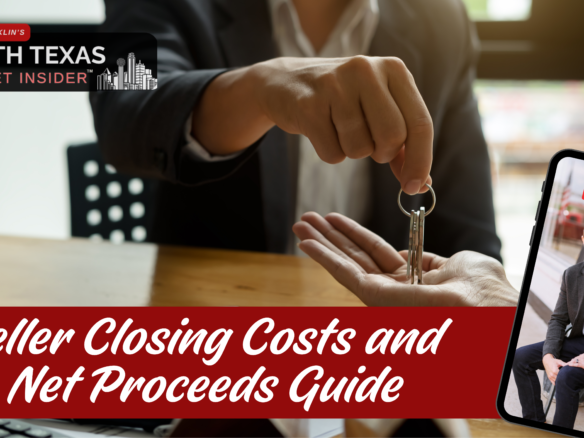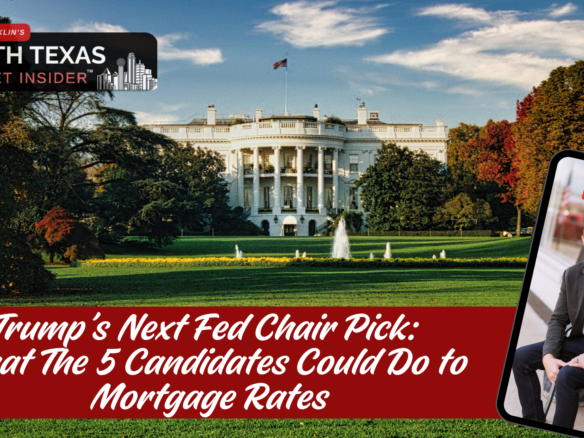Updated November 2025 | Bobby Franklin – North Texas Market Insider
Here’s what most agents won’t tell you: pricing your home is the most consequential strategic decision you’ll make in the entire selling process. Not the staging. Not the photography. Not even your marketing plan. The price.
Get it right, and you control the narrative. You attract serious buyers, generate competitive interest, and close on your timeline. Get it wrong, and you’re watching from the sidelines as your listing becomes stale, your leverage evaporates, and your final sale price bleeds out with each passing week.
Welcome to the North Texas market of late 2025, where chaos is creating massive opportunity for sellers who understand the game we’re actually playing.
The North Texas Reality Check: What the Numbers Are Really Telling Us

Let’s cut through the noise and talk about what’s actually happening in our market right now. The data tells a story, but you need to know how to read it.
Here’s your current North Texas market snapshot:
- Median sales price across North Texas: $363,665 (down 1.7% from last year)
- Average days on market: 61 days—up 15.1% from 2024
- Inventory levels: 51,915 units, up 12.7% year-over-year
- Sale-to-list price ratio: 95.21% in Dallas-Fort Worth
- Homes experiencing price reductions: 53.86%
Translation? We’ve shifted from the seller’s paradise of 2021-2022 to a balanced market where buyers actually have options again. Ellis County specifically has seen median values tick down 1.2% to around $400,000, while Fort Worth dropped 1.9% to $329,000. [1]
With mortgage rates hovering around 6.75% and months of inventory sitting at 5.4 months, here’s what this means for your pricing strategy: The days of throwing any number on your listing and watching buyers fight over it are over.
Good. Because that was never sustainable anyway.
This market rewards intelligence, preparation, and strategic positioning. Which is exactly where we’re about to take you.
Why Everything You Think You Know About Pricing Is Probably Wrong
Let me guess, you’ve been on Zillow. You’ve seen what your neighbor’s house sold for. You’ve calculated what you “need” to get out of your home to make your next move work. And you’ve convinced yourself that your renovated kitchen and new floors justify adding another $40,000 to the listing price.
Stop.
This is emotional pricing, and it’s the fastest way to cost yourself tens of thousands of dollars.
Here’s the uncomfortable truth: your memories don’t add value to buyers[9][41]. Neither do your feelings about your home. Neither does the fact that you “need” a certain price to make your financial situation work. [2]
The market doesn’t care what you need. The market doesn’t care that you spent $70,000 on renovations. The market only cares about one thing: what comparable buyers are willing to pay for comparable homes right now.
And right now, in North Texas, with inventory up and days on market climbing, buyers have leverage. They’re comparing your home against every other option in their price range. They’re seeing properties with price reductions. They’re taking their time.
Which means you need to be five steps ahead.
The Three Pricing Strategies: And When to Use Each One
Let’s break down the actual strategic approaches you can take, based on real market dynamics, not wishful thinking.
Strategy 1: Market Value Pricing (The Reliable Play)
This is what it sounds like: pricing your home at what the data shows it’s actually worth based on recent comparable sales[6]. It’s not sexy. It’s not bold. But for most North Texas sellers right now, it’s the smartest move.
When to use market value pricing:
- In balanced or buyer’s markets (like we’re in now)
- When you need to sell within a reasonable timeframe but aren’t desperate
- For homes with strong recent comparables in good condition
- When inventory is moderate and demand is steady
Why it works:
- You attract serious, qualified buyers who’ve done their homework.
- You generate consistent showing activity.
- You reduce appraisal risk, lenders won’t balk at financing your deal.
- You position competitively against similar listings without leaving money on the table.
The catch:
- You might not get multiple offers driving your price up
- Less room for negotiation since you’re already priced fairly
- It requires discipline to resist the temptation to “test the market” at a higher number
According to NAR data, homes priced at current market value typically sell for 100% of asking price. That’s not leaving money on the table, that’s getting exactly what your home is worth without the weeks of market time that cost you both money and leverage.
Strategy 2: Competitive Underpricing (The Calculated Risk)
This is where things get interesting. Competitive underpricing means listing 5-10% below estimated market value to create urgency and potentially spark multiple offers.
This is not desperation. This is chess.
When to use competitive underpricing:
- When you need to sell quickly and can’t afford extended market time
- In areas with low inventory where well-priced homes create feeding frenzies
- For unique properties where comparable sales are limited
- To create artificial urgency and competitive psychology
Top Chicago agent David Dominguez priced a home in Park Forest, Illinois 15-20% below market value due to limited comparables. The result? It sold for approximately $50,000 above asking price, which was 20% above actual market value.
How the psychology works:
When you price below market value, three powerful effects kick in:
- Search Visibility Explosion: Your home appears at the top of searches in your price range and catches buyers’ attention as exceptional value
- Perceived Opportunity: Buyers see your listing as a “great deal” compared to similar homes and feel urgency to act
- Competitive Pressure: Multiple interested buyers can drive the price up through bidding wars
Critical warning: This strategy has a narrow execution window. Going too far below market value triggers suspicion, buyers wonder what’s wrong with the property. And in the current North Texas market with increased inventory and longer days on market, the strategy of pricing low to spark bidding wars doesn’t work as reliably as it did in 2021-2022.
The sweet spot? 5-7% below market value in high-demand pockets where inventory remains tight and buyers are actively competing.
Strategy 3: Premium Pricing (The High-Wire Act)
Premium pricing means listing 5-10% above current market value, banking on your home’s unique features or strong buyer demand to justify the higher price.
Let me be direct: this strategy fails far more often than it succeeds.
According to HomeLight’s national survey of real estate agents, 77% of agents identified overpricing as the number one mistake sellers make. Not second. Not third. Number one.
When premium pricing might work:
- In high-demand areas with extremely low inventory (rare in current North Texas)
- For truly unique properties with features competitors genuinely lack
- When you’re not under any time pressure whatsoever
- In elite school districts where buyers pay premiums regardless of market conditions
Why it usually backfires:
Here’s the math nobody wants to talk about:
- Homes overpriced by just 10% can shrink your potential buyer pool by 50-75%
- Properties sitting on market longer sell for progressively less—not more
- Homes on market for 30-60 days sell for 4.75% less than asking price on average
- Homes on market for 120+ days sell for 8.5% below asking price
Dallas-Fort Worth agent Chandler Crouch puts it bluntly: when properties sit too long, buyers see “an opportunity for leverage” and come in 5-10% below asking price.
If you insist on testing premium pricing, commit upfront to reducing the price within 10-14 days if you’re not getting showings or offers. Waiting longer creates a stigma around your listing that’s almost impossible to overcome.
The First Two Weeks: Your Make-or-Break Window
Here’s a hard truth backed by data: your greatest chance of receiving full asking price or above occurs during the first two weeks your home hits the market.
NAR’s 2024 data breaks it down:
- Homes on market 4 weeks or less: 100% of asking price
- Homes on market 5-8 weeks: 98% of asking price
- Homes on market 9-16 weeks: 96% of asking price
- Homes on market 17+ weeks: 94% of asking price
Notice the pattern? Every week your home sits, your final sale price drops.
Research from Venturi Realty Group shows homes sold within the first 30 days were typically discounted by only 1% off the original list price, while homes taking 120 days experienced an average price reduction of 8.5%.
In North Texas specifically, we’re currently seeing homes spend an average of 61 days on market, significantly longer than the 25-40 days typical for correctly-priced homes in our region. This extended timeline gives buyers more negotiating power and increases the likelihood you’ll be forced into price reductions.
The strategic implication? Getting your price right from day one isn’t just important, it’s everything.
The Psychological Pricing Hack That Actually Works
Want to know a pricing strategy that legitimately increases both your visibility and your final sale price?
Price just below major round-number thresholds.
This is called “charm pricing,” and it’s the reason you see homes listed at $299,000 instead of $300,000, or $449,900 instead of $450,000.
Why this works:
1. Search Filter Visibility Doubles
Most buyers set their online searches in round-number increments, $250K, $300K, $400K, etc. If your home is listed at $299,000, it appears in searches for homes under $300,000 AND searches starting at $300,000. You’ve effectively doubled your visibility.
2. Psychological Perception
Research from the American Psychological Association shows buyers perceive prices ending in 9s as significantly lower, even when the difference is minimal. That $299,000 listing feels substantially cheaper than $305,000, even though it’s only $6,000 less.
3. Faster Sales, Higher Offers
A study of five years of real estate sales in Alachua County, Florida found that homes with precise pricing (like $497,500) sold more quickly than homes with round prices like $500,000. Initial offers for charm-priced homes were also higher.
Strategic price points for North Texas markets:
- List at $299,000 instead of $305,000 (Ellis County median range)
- List at $349,900 instead of $355,000 (Fort Worth median range)
- List at $399,000 instead of $410,000 (North Texas median range)
- List at $449,000 instead of $455,000 or $460,000
Atlanta agent Trent Aldridge notes that $450,000 is a major psychological threshold: “Listings priced under $450,000 seem to sell a lot quicker than listings over $450,000”.
One critical exception: If you’re selling luxury property over $750,000, round numbers actually convey prestige and quality. Charm pricing can backfire in high-end segments.
The Mistakes That Are Costing You Thousands (And How to Avoid Them)
Let’s talk about the landmines sellers keep stepping on, even when they know better.
Mistake #1: Letting Your Upgrades Dictate Your Price
You spent $70,000 on a kitchen renovation. You added $15,000 worth of landscaping. You put in new floors throughout.
None of this means you can add $85,000 to your asking price.
While certain upgrades absolutely add value, updated kitchens, bathrooms, fresh paint, modern landscaping, you typically won’t recoup 100% of your investment. According to NerdWallet’s analysis, you need to look at comparable homes to see if upgrades actually impact resale value in your specific market.
The strategic approach: Before investing in pre-sale improvements, consult with your agent about which updates will actually provide a return. Some improvements are table stakes (buyers expect them). Some are differentiators (buyers will pay more for them). Know the difference.
Mistake #2: Trusting Online Estimates More Than Market Data
Zillow’s Zestimate is convenient. Redfin’s algorithm is sophisticated. Neither one knows your home like a local agent who’s walked through it knows your home.
These automated tools don’t reflect:
- Current local market conditions in your specific neighborhood
- Your home’s actual condition (they’ve never seen inside)
- Recent upgrades or deferred maintenance
- Neighborhood-specific buyer demand trends
A professional Comparative Market Analysis (CMA) from a trusted local agent will give you a realistic picture of your home’s value. This service alone can be worth thousands of dollars by helping you avoid the costly mistake of overpricing.
Mistake #3: The “Price High and Negotiate Down” Trap
This is the most seductive, and most expensive, mistake sellers make.
The logic seems sound: “I’ll price high and leave room for negotiation. Worst case, I come down a bit.”
Here’s what actually happens:
Scenario: Overpricing a $400,000 Home at $440,000
- Week 1-2: Buyers searching up to $400K never see your listing
- Week 1-2: Buyers searching $400K-$450K compare your home to properties truly worth $420K-$450K
- Week 2-3: Your $400,000 home looks inferior next to genuine $440,000 homes with better features
- Week 3-4: Serious buyers skip your listing entirely
- Week 4-6: Your home develops market stigma—“what’s wrong with that one?”
- Week 6-8: You’re forced to reduce price after losing your best window
- Week 8+: You end up selling for less than you would have if priced correctly initially
The data is brutal: homes that sell quickly command higher prices. Homes that sit lose money every single week.
Mistake #4: Making Multiple Small Price Reductions
When price adjustments become necessary, sellers often reduce their price by small amounts, $2,000, $5,000, maybe $7,500, multiple times.
This signals desperation, not strategy.
According to HomeLight’s research on price reductions, small reductions aren’t enough to attract buyers in different search brackets or fundamentally change buyer perception. Instead, you signal uncertainty and weakness.
The better strategy: Make one meaningful reduction of 5-10% that repositions your home competitively. Cleveland agent Stephanie Termine often recommends an 8-10% decrease when homes aren’t getting showing activity.
NAR’s data tells the story:
- 65% of sellers sold for full asking price with no reductions
- 21% of sellers made one price reduction before selling
- Only 9% made two reductions, and just 4% made three
The more price reductions you make, the worse your outcome tends to be. One strategic move beats multiple reactive ones.
When to Lower Your Price (And How Much)
If your home isn’t selling, speed matters more than pride.
The Two-Week Rule
If you’re not getting serious showings or offers within the first two weeks, it’s time to reevaluate your price
According to iBuyer.com’s analysis of price adjustments, waiting longer only extends the problem. The data is clear: homes that sell quickly command higher prices.
Signs You Need a Price Adjustment
Red flags that your price is wrong:
- Low showing activity in the first 2-3 weeks
- No offers despite positive feedback on the home’s condition
- Comparable homes in your neighborhood are selling while yours sits
- Buyers love the home but feedback consistently mentions price concerns
How Much Should You Drop?
For modest overpricing (5-10% too high):
- Reduce by 5-7% to realign with market value
- Position yourself just below a major price threshold
- Example: From $415,000 to $389,900 (drops you into the sub-$400K search bracket)
For significant overpricing (10-15% too high):
- Reduce by 8-10% to generate renewed interest
- Consider this a market reset, not a failure
- Example: From $450,000 to $409,900 (major psychological repositioning)
Strategic timing matters:
- Make price changes mid-week (Wednesday or Thursday)
- This maximizes visibility going into the weekend when buyers are most active
- Avoid Friday afternoon or weekend changes that might get lost
Understanding Appraisals: The Price Reality Check
Even if you get a buyer to agree to your price, there’s still one more hurdle: the appraisal.
An appraisal is a professional evaluation of your home’s market value conducted by a licensed appraiser. Lenders require them to ensure they’re not loaning more money than the property is worth.
What appraisers evaluate:
- Comparable sales in your area (typically within the last 3-6 months)
- Your home’s condition, including foundation, roof, and major systems
- Size, layout, and number of bedrooms/bathrooms
- Location and neighborhood trends
- Quality of upgrades and improvements
Here’s the nightmare scenario:
- Your asking price: $450,000
- Buyer’s offer: $445,000
- Appraisal value: $415,000
What happens next:
- The lender will only approve a loan based on the $415,000 appraisal
- The buyer needs to come up with an additional $30,000 in cash
- If they can’t, you must either lower your price or the deal falls through
According to Rocket Mortgage’s explanation of how appraisals affect selling price, this is why pricing at or near market value from the start protects you from wasted time and failed transactions.
In a balanced market like North Texas in late 2025, sales prices and appraisal values should align closely. If they don’t, it’s usually because the sales price is too high.
The Legal and Ethical Framework You Need to Know
As a North Texas seller, you’re operating within a specific legal and ethical framework. Understanding these rules protects you and ensures a smooth transaction.
Fair Housing Act Requirements
The Fair Housing Act prohibits discrimination in housing based on race, color, religion, sex, disability, familial status, or national origin.
What this means for pricing:
- You cannot set different prices based on a buyer’s protected characteristics
- You cannot refuse to negotiate with buyers based on protected classes
- All pricing decisions must be based on legitimate market factors
Violations carry significant penalties. According to HUD’s 2021 penalty structure, first violations result in fines up to $21,663, with penalties increasing for repeat violations.
RESPA (Real Estate Settlement Procedures Act)
The Real Estate Settlement Procedures Act protects homebuyers from hidden fees and abusive practices during the settlement process
Key RESPA requirements in Texas:
- Transparency in all settlement costs
- Prohibition of kickbacks between real estate professionals and service providers
- Required disclosures about loan servicing and escrow accounts
RESPA violations can result in civil fines up to $10,000 per violation, plus criminal charges in serious cases.
NAR Settlement Changes (Effective August 2024)
Following the NAR settlement, significant changes now govern how buyer agent compensation works:
- Buyer agents must have written agreements with buyers before showing homes
- Compensation cannot be advertised on MLS listings
- Buyers are now responsible for ensuring their agents are compensated (though sellers can still offer to pay via concessions)
- Commission rates are fully negotiable and not set by law
What this means for you: You can still offer to pay buyer agent commissions as a seller concession to make your home more attractive but this must be negotiated directly with buyers and their agents rather than advertised upfront.
Your North Texas Pricing Checklist
Before you list your home in Ellis County, Waxahachie, or anywhere in the DFW metroplex, run through this checklist:
✓ Get a Professional CMA
- From an experienced local agent who actually knows your specific market
- With at least 3-5 recent comparable sales
- Including active listings and pending sales data
✓ Understand Current Market Conditions
- Review regional data from Texas Real Estate Research Center
- Check neighborhood-specific trends, not just metro-wide averages
- Recognize that North Texas is in a balanced market with more buyer leverage
✓ Choose the Right Pricing Strategy
- For most North Texas sellers right now: market value or competitive underpricing
- Avoid premium pricing unless you have strong justification and unlimited time
- Consider psychological pricing just below round numbers
✓ Set Realistic Timeline Expectations
- Average 61 days on market for North Texas currently
- Best results come in first 2-4 weeks
- Be prepared to adjust after 14-21 days with no offers
✓ Prepare for Market Feedback
- Establish criteria upfront for price adjustments
- Plan for one meaningful reduction (5-10%) rather than multiple small cuts
- Monitor showing activity and buyer feedback weekly
✓ Ensure Legal Compliance
- Work with agents who follow NAR Code of Ethics
- Understand Fair Housing Act requirements
- Ensure RESPA compliance
- Understand new NAR settlement buyer agent compensation rules
Final Strategic Thoughts: Playing the Long Game
Here’s what I want you to understand: pricing isn’t about what you want, it’s about what the market will bear right now.
The North Texas market of late 2025 is creating opportunities for sellers who price strategically based on data, not emotion. But it’s also punishing sellers who overprice and wait for buyers who aren’t coming.
With inventory rising, days on market increasing, and buyers having more negotiating power, the old strategies of overpricing and hoping don’t work anymore.
The homes that sell quickly and for top dollar are those priced correctly from day one.
Every day your home sits on the market costs you money in holding costs and reduces your final sale price. The difference between a home that sells in 30 days versus 90 days can be thousands, sometimes tens of thousands, of dollars.
This isn’t about being pessimistic. This is about being strategic.
While other sellers are playing checkers, hoping for the best, reacting to market feedback, making emotional decisions, you’re playing chess. You’re pricing strategically. You’re positioning competitively. You’re maximizing your leverage in the narrow window where you have it.
That’s the North Texas Market Insider advantage.
📊 Weekly market intel + insider opportunities
🎯 Text 214-228-0003 for the VIP list
Bobby Franklin – REALTOR®
Legacy Realty Group – Leslie Majors Team
Serving Ellis County & DFW
Disclaimer: This guide provides general educational information and should not be considered legal, financial, or professional real estate advice. Real estate markets change constantly, and individual circumstances vary. Always consult with licensed professionals before making pricing decisions. All pricing strategies should comply with federal Fair Housing Act requirements, RESPA regulations, and NAR Code of Ethics standards. Market data referenced is current as of November 2025 and subject to change.
About This Analysis: This comprehensive resource draws from analysis of over 80 current sources on real estate pricing strategies, market trends, and ethical practices, combined with direct North Texas market intelligence and strategic positioning frameworks. All recommendations align with National Association of REALTORS® guidelines, Fair Housing Act requirements, RESPA regulations, and Texas Real Estate Commission standards.






Join The Discussion